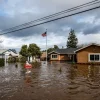Central Europe is grappling with severe flooding as rivers continue to swell under the influence of Storm Boris.
Over the past four days, this storm has delivered up to five times the usual September rainfall across Austria, the Czech Republic, Hungary, Poland, Romania, and Slovakia. The resulting deluge has submerged entire neighborhoods and prompted large-scale evacuations.
The storm has claimed at least 21 lives across the affected countries, with Romania, Poland, Austria, and the Czech Republic experiencing the highest fatalities.
While rainfall has started to decrease in some areas, water levels remain dangerously high in others, with expected peaks still days away.

In Slovakia, the Danube River has already reached its peak, leading to flooding in parts of Bratislava’s old town. Meanwhile, Hungary is seeing a rising Danube, with levels increasing by approximately one meter per day in Budapest.
In response, mobile dams are being deployed in historical towns such as Visegrád and Szentendre, and extensive sandbagging efforts are underway.
Eastern Germany is also on alert, with mobile flood protection walls installed in Dresden as the Elbe River continues to rise. The river is expected to reach its peak by midweek.
Poland’s historical city of Wrocław is preparing for potential peak flooding of the Oder River by Friday. Evacuation buses are on standby, and the local zoo has called for volunteers to assist with sandbagging efforts.
In Austria, particularly in Lower Austria, the situation remains dire with broken dams, flooded villages, and thousands without essential services.
The Austrian government has declared a disaster zone and allocated emergency funds to address the crisis. Rainfall in St. Pölten has surpassed historical records, leading to significant disruption.
Looking ahead, while conditions are expected to improve slightly by late Tuesday, Storm Boris is forecast to move into northern Italy, where heavy rainfall is anticipated.

